How to amplify a gigging Gypsy jazz band
Everything should be made as simple as possible, but not simpler. (Albert Einstein)
There's always an easy solution to every human problem — neat, plausible, and wrong. (H. L. Mencken)
Huh? What have these quotes got to do with how we amplify the musical instruments — acoustic violin, acoustic guitar, keyboard, and fretless bass — which FiddleBop uses to play “Gypsy jazz re-imagined” at live gigs? Everything, as it turns out. Our mostly trial-and-error experiences have helped us to get a good live sound. With a setup that is as simple as we can get it. But not too simple (ho ho!).
So I’ve written this summary in the hope that it may be useful to others (just as I hope that the Is it OK to call this music "Gypsy jazz"? discussion might be useful.) If anything isn't clear, or if you disagree with what I say, or if you would like more information, then email me at info@fiddlebop.org. Good luck with getting your own music amplified just as you would like it!
Amplification in the past
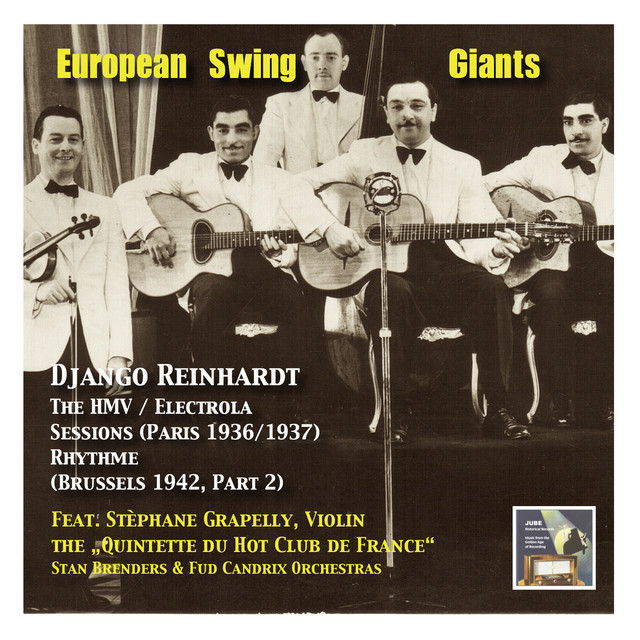
Being heard properly was a major problem faced by the originators of Gypsy jazz, Django Reinhardt and Stéphane Grappelli in the Quintette du Hot Club de France back in the 1930s. Jazz bands of that time mostly consisted of brass instruments, Which are LOUD. Acoustic (un-amplified) violins and guitars just can’t produce the same sort of volume. So Django and Stephane and the band, unamplified, would have been easily overwhelmed aurally by any lively and chatty Parisian audience. Swing-era dancers would have drowned out the band, no question.
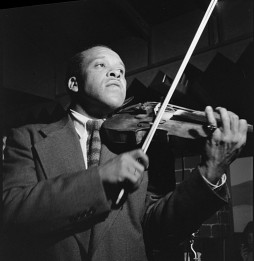
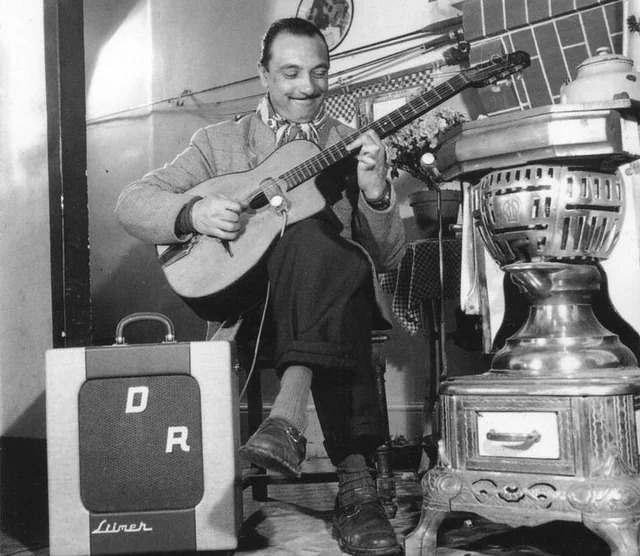
Fortunately, microphones were becoming common in venues around this time. This rise of microphone-based live amplification was a game-changer for early Gypsy jazz. OK, there might only have been one microphone shared by the whole band, but that would have been a great deal better than nothing.
At around the same time over in the US, jazz violinists Joe Venuti and the wonderful Stuff Smith were experimenting with the first electrically amplified violins. And a few years later on, Django began playing guitars with electric pickups.
Amplification now
The need for relatively quiet instruments to be heard over background noise in live venues is still with us in 2024, nearly a century after the Quintette of the Hot Club de France. Also, audience expectations have risen: the quality of live sound is now expected to be similar to that of a studio recording. OK, technological advances in audio engineering during this century have been immense. So why isn’t it a piece of cake (or a walk in the park) to get a good live sound — using equipment that is quick and easy to set up, and which works reliably — for FiddleBop’s instruments[1]?
Let’s take one instrument at a time.
Amplifying an acoustic nylon-string rhythm guitar
FiddleBop, like most gypsy jazz bands, does not have a drummer or percussionist. This means that we are totally, 100%, reliant on Jo’s rhythm guitar playing to keep us in time. (Not for nothing do we say that “Jo is the rhythmic foundation of FiddleBop”.) If we can’t clearly hear her guitar's rhythm, we can’t play well as a band. This could be a problem, given that some FiddleBop numbers verge on being both fast and rhythmically intricate 😃. Which is why amplifying Jo’s nylon-string guitar is the most important thing that we have to do, live sound-wise. Both for the band’s ability to play decently, and to ensure that Jo’s contribution to the overall FiddleBop sound is as good as it possibly can be. Easy? Nope.
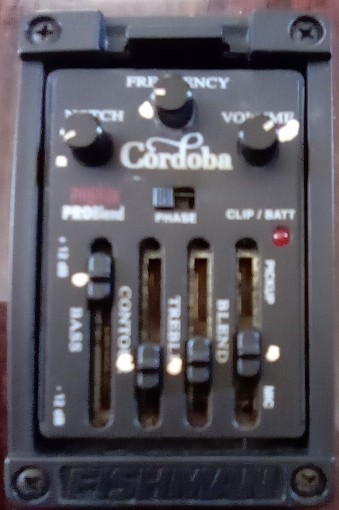
Jo plays a Cordoba Gipsy Kings Pro Negra nylon-string (“Spanish”) guitar[2]. It is fitted with a Fishman Pro Blend pre-amplifier, which has two sound sources: an under-bridge piezo, and an internal microphone. These can be blended, as the pre-amp's name suggests. Jo has found, tho’, that for her playing style the best sound comes almost wholly from the internal microphone. Which is great, but which makes the guitar liable to generate feedback if the guitar's amplified sound enters the guitar’s soundhole i.e. comes from the front of the stage back towards Jo. Feedback is much less of a problem if amplification is at the rear of the guitar i.e. from a backline amplifier behind Jo. Which means that monitoring of Jo’s guitar from the front of the stage, back towards the band, is a no-no for us.
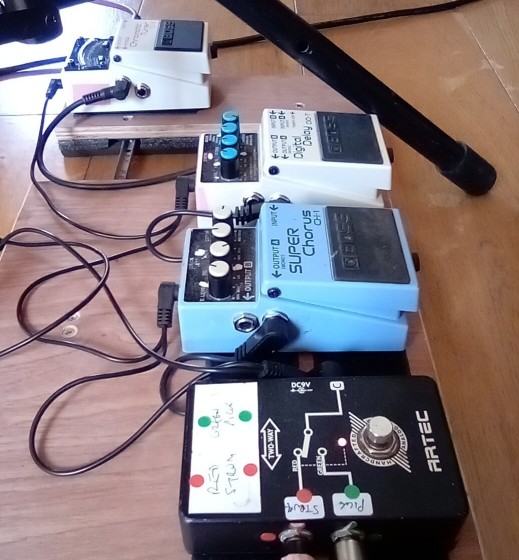

There’s more. Jo sometimes strums her guitar, at other times she uses fingerstyle picking. Each of these requires a notably different EQ and volume setting. She swaps between these settings by means of an Artec footswitch on her pedalboard, which switches her guitar’s output to one or other of the two channels of her Headway Shire King 60 backline amp. Each channel on the Headway has a different EQ and volume setting. The amplified output from her Headway is a blend of these two channels (only one of which is in use at any time, however.)
The Headway is always positioned behind Jo, and it functions as a monitor both for Jo and for the rest of the band. And if we are playing in anything but a tiny venue, the Headway’s Line Out signal goes to a mono DI box (a Behringer Ultra DI 100) which then routes Jo’s guitar sound to one channel of the front-of-house PA system.
Amplifying an acoustic violin
Dave's acoustic violin is (probably) German, (probably) about 100 years old. I have owned it for many years[3]. During Covid lockdown — what else was there to do? — Richard (aka Titch) of Sonic Violins installed a piezo bridge and an internal battery-driven pre-amplifier. This works brilliantly! However, as with any amplified acoustic instrument, the violin can still generate feedback if it picks up its own amplified sound. So I avoid in-front monitoring i.e. sound which comes from the front of the stage back towards me. Instead I — and the rest of the band — rely on hearing the sound from my Headway Shire King 60 backline amplifier.

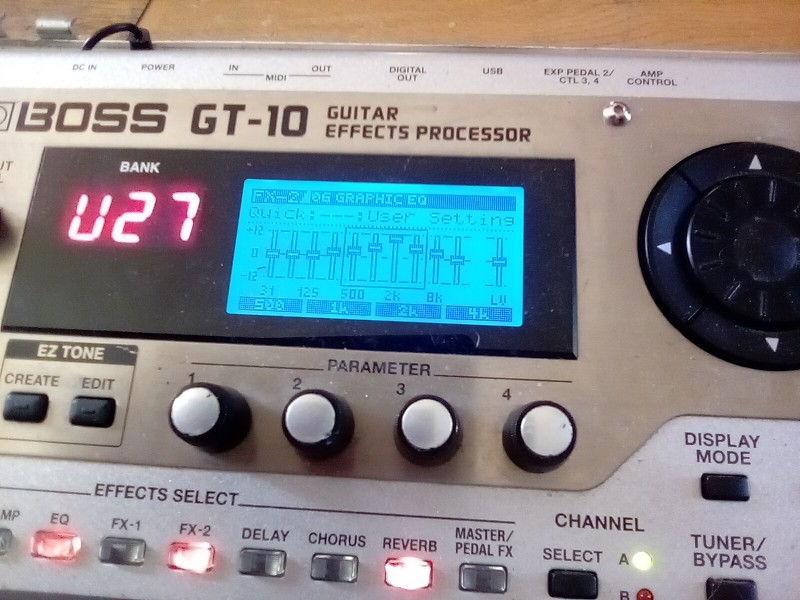
Also, as with any piezo pickup, there is a need to remove “piezo quack” (Google it!) at around 1.2 kHz or thereabouts. I do this with the EQ wizardry in my Boss GT-10 effects unit. And in anything but the smallest and most quiet-as-a-mouse venues, I also use a mono DI box (again, a Behringer Ultra DI 100) between the effects unit and the Headway. This sends my violin sound to one channel of the front-of-house PA system.
Electric keyboard amplification
In contrast with Jo’s acoustic guitar and my acoustic violin, Paul's keyboard is very straightforward, amplification-wise. What a relief! For live gigs, Paul plays a Yamaha P120. He and the rest of the band get to hear his dulcet tones via a Behringer B210D monitor, used as a backline amp[4] and usually positioned just behind Paul, so that he and the rest of the band can hear it.
When we have a front-of-house PA, the keyboard sound reaches it via a Behringer Ultra DI 100, which wiring-wise is between the keyboard and the monitor.
Fretless electric bass amplification
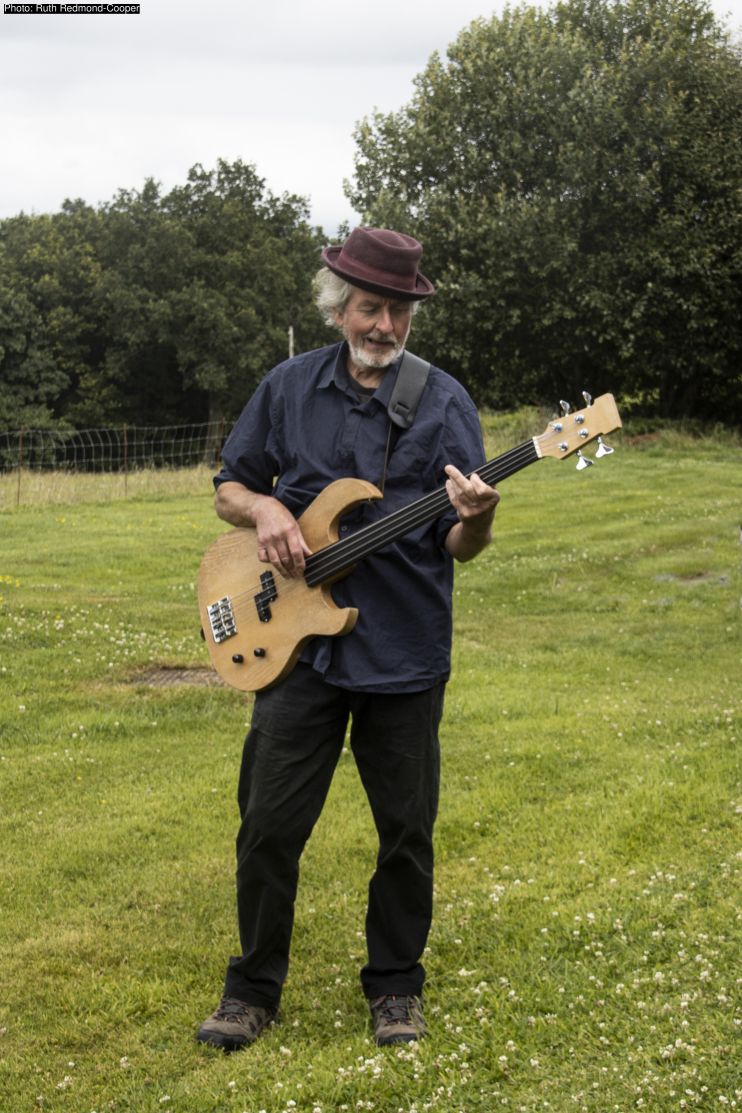
And the amplification setup for Graeme's solid electric fretless bass is also straightforward. Hooray! The bass is by Lamble Guitars: Graeme made it himself (isn't he clever?). The melodious sound of this bass reaches all our ears by means of another Behringer B210D monitor, again used as a backline amplifier and usually positioned just behind Graeme.
Just like the keyboard setup, the bass sound goes to a front-of-house PA via a Behringer Ultra DI 100, which is connected between the bass and the monitor.
Summary and more
Yup, amplification for FiddleBop ranges from “easy and straightforward” for the keyboard and bass; through “reasonably easy” for the violin; all the way through to “rather difficult” for the guitar. It has taken some time and experimentation to get our setup working well, but it was — for sure! — worth the effort. Probably it would have been even trickier if we had a drummer: since we don't, we can keep sound levels low on stage, and so minimize the risk of feedback.
I've touched on the desirability of a "quick and easy" set up for your amplification, but haven't said much about this. We've found that marking the correct position of each knob or slider (in other words, the position that you've settled on after hours and hours of experimentation, by which time your ears have gone numb) with a dob of correction fluid — one brand being Tippex — is a great time-saver. One glance and you are done (see the pics of Jo's pre-amp and amp, above). And it is easy enough to scrape off the dob if you later change your mind about the optimum position. Another thing that helps greatly speed-wise is having colour-coded cables, with coloured dots close to connectors and sockets showing what goes where (see the pics of Jo's amp and pedalboard above). This helps with the "reliable" goal too: if once you've set up you find that something doesn't work, the chances are high that it is a cable problem. Having colour-coded cables makes it easy to identify the problem cble, and then replace it with a backup. We also mark all FiddleBop's cables and equipment with coloured electrical tape. It is surprising how easy it is to leave one of your own cables behind, or pick up someone else's by mistake, in the chaos of post-gig packing up.
By the way, the various makes and models of equipment mentioned here are just our choices. We like 'em but you might well choose something different. No problem 😃.
That's it! I hope that this is useful to someone, somewhere, sometime. Good luck with your music, and thanks for reading this far!
- I’m not going to discuss amplifying vocals here. This essay is already too long! ↩
- Interestingly — considering Jo's style of playing — Cordoba describe this as a flamenco-style guitar. We've found it to be a bit brighter, and more percussive, than most classical guitars. ↩
- And almost ruined it with superglue. Don’t ask... ↩
- We've found that we have to cut the bass on the keyboard monitor, to avoid frequency overlap with Graeme's bass. ↩





 info@fiddlebop.org
info@fiddlebop.org 01982 560726
01982 560726 Site map
Site map @FiddleBop
@FiddleBop @FiddleBop
@FiddleBop Get our email newsletter
Get our email newsletter


